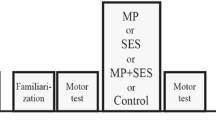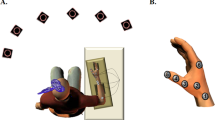Abstract
Training on a motor task results in performance improvements that are accompanied by increases in motor cortex excitability. Moreover, periods of afferent stimulation result in increased motor cortex excitability. There is increasing evidence to suggest that raised motor cortical excitability may facilitate movement and learning. Here we examined whether a period of electrical stimulation of hand afferents (“associative stimulation”), known to increase motor cortex excitability, facilitated the performance of a complex sensorimotor task. Three groups of nine normal subjects participated in these studies. All subjects were trained on the grooved pegboard test (GPT). Training consisted of three blocks, each of five trials, of placing pegs as quickly as possible. The time to complete each block was recorded. One group of subjects had a 1-h period of associative stimulation prior to training on the GPT. A second group received non-associative stimulation (which does not change cortical excitability) of the same hand afferents while a third group received no stimulation prior to training. Motor evoked potentials (MEPs) were recorded from the first dorsal interosseous (FDI) and abductor digiti minimus (ADM) muscles both prior to and following stimulation and performance of the GPT. In contrast to non-associative stimulation, associative stimulation increased motor cortical excitability, as evidenced by an increase in the amplitude of MEPs evoked in the FDI, one of the stimulated muscles, but not the ADM. Training on the GPT resulted in significant improvements in the time taken to complete the task for all three groups. However, in subjects who had preconditioning associative stimulation, performance on the GPT improved more rapidly. Additionally, there was a strong trend for the improvement in the performance of the stimulated group to be greater than that of the control group. The results of the present study suggest that increased motor cortical excitability, induced by associative stimulation, may facilitate the performance of a novel complex sensorimotor task.



Similar content being viewed by others
References
Antal A, Nitsche MA, Kincses TZ, Kruse W, Hoffmann KP, Paulus W (2004) Facilitation of visuo-motor learning by transcranial direct current stimulation of the motor and extrastriate visual areas in humans. Eur J Neurosci 19:2888–2892
Butefisch CM, Davis BC, Wise SP, Sawaki L, Kopylev L, Classen J, Cohen LG (2000) Mechanisms of use-dependent plasticity in the human motor cortex. Proc Natl Acad Sci U S A 97:3661–3665
Butefisch CM, Khurana V, Kopylev L, Cohen LG (2004) Enhancing encoding of a motor memory in the primary motor cortex by cortical stimulation. J Neurophysiol 91:2110–2116
Classen J, Liepert J, Wise SP, Hallett M, Cohen LG (1998) Rapid plasticity of human cortical movement representation induced by practice. J Neurophysiol 79:1117–1123
Garry MI, Kamen G, Nordstrom MA (2004) Hemispheric differences in the relationship between corticomotor excitability changes following a fine-motor task and motor learning. J Neurophysiol 91:1570–1578
Hamdy S, Rothwell JC, Aziz Q, Singh KD, Thompson DG (1998) Long-term reorganization of human motor cortex driven by short-term sensory stimulation. Nat Neurosci 1:64–68
Hummel F, Celnik P, Giraux P, Floel A, Wu WH, Gerloff C, Cohen LG (2005) Effects of non-invasive cortical stimulation on skilled motor function in chronic stroke. Brain 128:490–499
Karni A, Meyer G, Rey-Hipolito C, Jezzard P, Adams MM, Turner R, Ungerleider LG (1998) The acquisition of skilled motor performance: fast and slow experience-driven changes in primary motor cortex. Proc Natl Acad Sci U S A 95:861–868
Muellbacher W, Ziemann U, Boroojerdi B, Cohen L, Hallett M (2001) Role of the human motor cortex in rapid motor learning. Exp Brain Res 136:431–438
Nitsche MA, Paulus W (2000) Excitability changes induced in the human motor cortex by weak transcranial direct current stimulation. J Physiol 527(Pt 3):633–639
Nitsche MA, Schauenburg A, Lang N, Liebetanz D, Exner C, Paulus W, Tergau F (2003) Facilitation of implicit motor learning by weak transcranial direct current stimulation of the primary motor cortex in the human. J Cogn Neurosci 15:619–626
Pyndt HS, Ridding MC (2004) Modification of the human motor cortex by associative stimulation. Exp Brain Res 159:123–128
Ridding MC, Taylor JL (2001) Mechanisms of motor-evoked potential facilitation following prolonged dual peripheral and central stimulation in humans. J Physiol 537:623–631
Ridding MC, Uy J (2003) Changes in motor cortical excitability induced by paired associative stimulation. Clin Neurophysiol 114:1437–1444
Ridding MC, Brouwer B, Miles TS, Pitcher JB, Thompson PD (2000) Changes in muscle responses to stimulation of the motor cortex induced by peripheral nerve stimulation in human subjects. Exp Brain Res 131:135–143
Rioult-Pedotti MS, Friedman D, Donoghue JP (2000) Learning-induced LTP in neocortex. Science 290:533–536
Rioult-Pedotti MS, Friedman D, Hess G, Donoghue JP (1998) Strengthening of horizontal cortical connections following skill learning. Nat Neurosci 1:230–234
Rossini PM, Barker AT, Berardelli A, Caramia MD, Caruso G, Cracco RQ, Dimitrijevic MR, Hallett M, Katayama Y, Lucking CH et al (1994) Non-invasive electrical and magnetic stimulation of the brain, spinal cord and roots: basic principles and procedures for routine clinical application Report of an IFCN committee. Electroencephalogr Clin Neurophysiol 91:79–92
Stefan K, Kunesch E, Cohen LG, Benecke R, Classen J (2000) Induction of plasticity in the human motor cortex by paired associative stimulation. Brain 123(Pt 3):572–584
Stefan K, Kunesch E, Benecke R, Cohen LG, Classen J (2002) Mechanisms of enhancement of human motor cortex excitability induced by interventional paired associative stimulation. J Physiol 543:699–708
Tremblay F, Wong K, Sanderson R, Cote L (2003) Tactile spatial acuity in elderly persons: assessment with grating domes and relationship with manual dexterity. Somatosens Mot Res 20:127–132
Ziemann U, Iliac TV, Pauli C, Meintzschel F, Ruge D (2004) Learning modifies subsequent induction of long-term potentiation-like and long-term depression-like plasticity in human motor cortex. J Neurosci 24:1666–1672
Acknowledgments
This work was supported by a grant from the Australian Research Council. MCR is a QEII Fellow of the Australian Research Council and MNM is supported by an Australian Postgraduate Award.
Author information
Authors and Affiliations
Corresponding author
Rights and permissions
About this article
Cite this article
McDonnell, M., Ridding, M. Afferent stimulation facilitates performance on a novel motor task. Exp Brain Res 170, 109–115 (2006). https://doi.org/10.1007/s00221-005-0192-x
Received:
Accepted:
Published:
Issue Date:
DOI: https://doi.org/10.1007/s00221-005-0192-x




